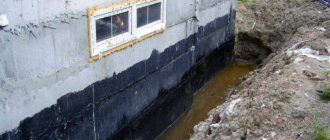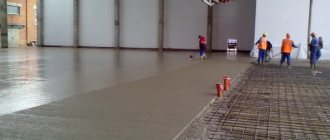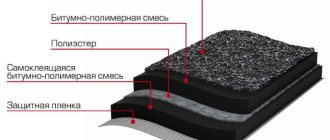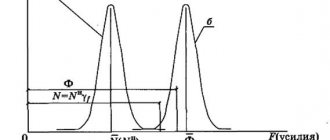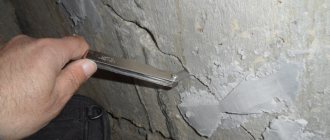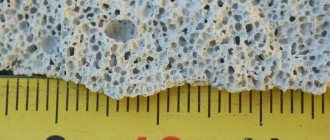CemAquaStop
Complex moisture-repellent agent for surface treatment.
More details
At subzero temperatures, the water in the capillaries freezes, increasing in volume and breaking the concrete structure.
Thus, the harmful effects of moisture go in several directions at once, and unprotected concrete can be destroyed in just a few years (destruction of unprotected concrete on the outside of the structure can reach 2 cm per year).
Mastic for concrete waterproofing
The main advantage of mastic waterproofing is the fluidity of the material, due to which mastic is used for hard-to-reach places in concrete structures. After treating the surface, there are no joints or seams left, the mastic smooths out all the unevenness.
Kawabanga! Fillers for concrete and mortars: what are they, types
There are 2 groups of mastic insulation:
- bitumen;
- polyurethane.
Bitumen mastic is one of the available ones; a heated mixture is used for work. In order to increase fluidity and elasticity, polymer additives are added to the material.
Polyurethane mastic has less weight than bitumen mastic, so it is often used for waterproofing concrete floors of buildings.
What structures need waterproofing?
Of course, not every structure made of concrete requires mandatory protection from moisture.
But there are types of structures for which waterproofing is necessary:
- swimming pools;
- hydraulic structures;
- structures that are used outdoors and exposed to adverse factors (for example, external walls of buildings);
- products that are in contact with the ground (foundations, basement floors, especially if the building is located on wet soil or soil with a high level of groundwater);
- technical and production premises with high humidity (kitchen, bathroom).
Therefore, when designing construction, all climatic factors are taken into account (according to SP 131.13330), temperature and humidity conditions, both inside and outside the building, the level of groundwater and the possibility of its seasonal increase, harmful effects on concrete of any nature.
Important!
Waterproofing must be carried out during the construction of the building, but sometimes it is carried out during repairs or reconstruction; in this case, the factors that led to the damage are taken into account.
What methods of concrete protection exist?
In accordance with SP 28.1333-2017 “Protection of building structures from corrosion. Updated edition of SNiP 2.03.11-85”, there are two main types of concrete protection methods:
- primary;
- secondary.
Primary protection is carried out during design, as well as during the manufacturing process of structures. This method of protection consists in choosing solutions that reduce the impact of aggressive factors and such materials that will be resistant to the operating environment (for example, the use of water-resistant concrete, the choice of certain types of cement, shifting the water-cement ratio, the use of water-repellent and plasticizing additives, fibers). These measures can be applied individually or in combination.
We advise you to study: Water repellents for concrete
Secondary protection is used if primary protection measures are not enough and includes the use of impregnations, protective coatings and other insulation methods.
Important!
According to the joint venture, primary protection methods are used first in new construction; secondary methods are used as additional ones (if primary methods are not enough).
Thus, waterproofing measures include methods of secondary protection of concrete. They are used mainly in conditions of moderately and highly aggressive environments in conjunction with primary protection methods. Their essence is to create an insulating, waterproof layer on the surface of concrete, and this can be done in different ways and through the use of different types of materials.
What materials are used for waterproofing concrete?
There are several main types of concrete waterproofing that protect its surface.
Treatment with water-repellent compounds (impregnations)
The essence of the method is to apply a special polymer-based composition to the concrete surface; after drying, a thin, vapor-permeable, water-repellent film is formed on the surface, which protects the concrete from getting wet, dirty, and efflorescence without interfering with its ability to “breathe.”
Liquid waterproofing for concrete: characteristics
In addition to dry mixtures for waterproofing, there are also liquid compositions
- liquid rubber;
- liquid glass.
The nuances of using liquid waterproofing for concrete
Liquid waterproofing for concrete must be applied with a brush or roller
Liquid water insulation is resistant to high temperatures, so in the summer there is no need to worry that it will start to melt. This material is an excellent alternative to rolled and other insulators.
CemAquaStop
Complex moisture-repellent agent for surface treatment.
More details
This treatment completely eliminates water absorption and increases the frost resistance of concrete.
Treatment with hyalrophobic compounds must be repeated periodically, every few years.
We advise you to study: CemAquaStop
Treatment with penetrating compounds
Penetrating impregnations are applied to a damp surface; their components react with concrete and form strong crystalline water-repellent compounds.
These impregnations can penetrate concrete to a depth of 10–20 cm. They not only form a water-repellent layer, but also strengthen the concrete surface.
Cladding with piece elements
Tiling, for example, is an old, proven method of protecting the surface of concrete, but it is not suitable for every situation. In addition, this is a labor-intensive and rather expensive method. It must be combined with other methods, for example, treating the concrete surface with biocides or impregnations.
Pasting
Pasting the concrete surface with film, roll or sheet materials based on bitumen is an old and common method of waterproofing. Materials can be glued or fused. This also includes self-adhesive films and membranes.
Penetrating waterproofing
Figure 2. Types of concrete waterproofing
Penetrating waterproofing is a mixture or impregnation that penetrates into the concrete structure, plugging holes and preventing moisture from seeping inside. Its key advantage is that the mixture protects the material from the inside, providing reliable protection.
Important: the penetrating method is considered relatively new, but in fact this option has been successfully used for more than half a century. This method was first used in Denmark in the middle of the 20th century.
Penetrating waterproofing compounds have the following properties:
- the mixture can be used to protect both underground and above-ground buildings;
- the composition can be applied on a damp surface - the quality will not suffer from this;
- when using this method, a seamless coating is obtained;
- the compositions can be applied to the inner surface of the walls.
Advantages
Penetrating waterproofing has recently been used very actively, since it is ideal for buildings in contact with liquids or subject to constant exposure to water.
The main advantages of this type of waterproofing are as follows:
- the vapor permeability of the structure is maintained;
- easy application of the composition;
- use on structures of any age;
- can be used on a damp surface;
- extends service life;
- the mixture is environmentally friendly.
Important. All work must be carried out wearing protective gloves.
Flaws
Despite the undeniable advantages, this method of concrete protection is not without its disadvantages. These include:
- high price;
- preparing the material before application - degreasing, removing paint residues;
- the concrete must be thoroughly cleaned so that the mixture can penetrate inside;
- this type of waterproofing is not suitable for brick, gas blocks and foam blocks;
- the prepared solution should be consumed within 30 minutes after preparation, otherwise it will lose its properties;
- the composition cannot be worked at low temperatures.
Important. Penetrating mixtures should be applied by professionals who are well versed in the nuances and features of this method.
CemAquaStop
Complex moisture-repellent agent for surface treatment.
More details
The disadvantages of this method include labor intensity and the possibility of condensation appearing under the waterproofing materials.
Paint and varnish coatings
In this case, a layer of varnish or special paint acts as a waterproofing layer.
Coating waterproofing
This type of waterproofing is performed by applying bitumen or polymer materials or liquid glass.
Liquid glass, although it forms a waterproof layer, is not a very reliable method of protecting concrete from moisture. Most often, liquid glass treatment is carried out for slightly aggressive environments or as a primer.
Modern coating waterproofing is mainly polymer-based mastics.
Mastics are special materials that are applied to the surface of concrete to obtain seamless elastic waterproofing.
Mastics have advantages over pasting and lining: they do not have seams and are easy to apply.
These are environmentally friendly materials that have the following characteristics:
- excellent adhesion to different types of building materials;
- thixotropy, due to which they can be applied to walls and ceilings;
- elasticity;
- quick drying;
- economical consumption.
Mastics are supplied ready for use, packaged in buckets. To apply them you will need a roller or a hard brush.
Modern high-tech materials make it possible to achieve high-quality gyroproofing of concrete products even in highly aggressive environments. Cemmix mastics and dry mixes are materials developed taking into account modern technologies. They are available for purchase, easy to use and reliable.
You can buy CemPlast, CemBase CEMMIX without leaving your home, with discounts from 5 to 33%!!!!
Buy on Ozon
Buy on VseInstrumenty.ru
Buy on Wildberries
Buy at Leroy Merlin
Types of liquid waterproofing
- liquid rubber;
- liquid glass.
Return to contents
Liquid rubber insulation
Peculiarities
Now let's look at a few nuances that can reduce the quality of such a coating:
Bitumen-containing coatings based on organic solvents are used for outdoor work or in rooms with an effective ventilation system. Recommended for use on small surfaces.
Application technology
An important nuance - if application is carried out with a brush or roller, then the first time the coating is applied with movements left and right, and the second time - down and up. Average material consumption 1 m²/l for one layer.
Waterproofing with liquid glass
Coating and penetrating waterproofing
Based on the methods of waterproofing with liquid glass, it is differentiated into:
- coating;
- penetrating.
Penetrating insulation is used when sealing seams and joints, as well as when it is necessary to quickly eliminate a leak. Liquid glass is also added directly to the concrete solution during construction.
Features of waterproofing with liquid glass
An important point is the rapid crystallization of liquid glass. Therefore, in order not to spoil a lot of material, it is better to entrust the work of applying it to specialists. The advantages include:
- reliable grip on any surface;
- a solid waterproof surface is created;
- low material consumption;
- cheapness.
Kawabanga!
Mold lubricant Disadvantages include:
- lack of elasticity;
- impossibility of independent use. The substance is introduced as an additive to other building materials;
- difficulty of application due to the rapid drying of the solution.
Return to contents
Proportions of liquid glass and cement
However, there are other ratios of components:
Rules for working with liquid glass
Although the substance itself is harmless to humans, when combined with water, a strong alkaline reaction occurs; if it gets on the skin, you should rinse the area well with running water. Working with gloves is a must.
It is important to note that the material is never added to a ready-made concrete solution. It is introduced with water into dry cement at the mixing stage.
Application technology
The isolation process is quite simple if you follow all the rules:
